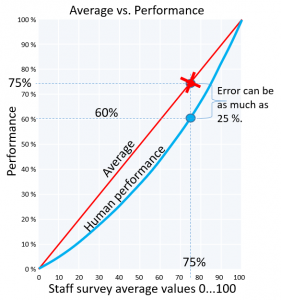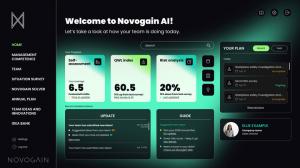AI Creates a Virtual 11th Employee – Motivation Theory Reveals Why Most Employee Surveys Are Scientifically Wrong
New research shows traditional employee surveys misleads AI analytics and overestimate human performance.
When AI systems are trained using incorrect employee experience data, they produce wrong recommendations for leadership and performance improvement.”
OULU, FINLAND, October 6, 2025 /EINPresswire.com/ -- AI Creates a Virtual 11th Employee – Motivation Theory Reveals Why Most Employee Surveys Are Scientifically Wrong— Marko Kesti
Subtitle:
New research shows traditional employee surveys misleads AI analytics and overestimate performance, while Novogain’s motivation-based QWL Pulse unlocks hidden workforce capacity.
A new scientific study reveals that most employee surveys are methodologically flawed and systematically overestimate workforce performance. According to motivation theory, which explains how human drive and engagement translate into performance, the average employee satisfaction score does not correlate with actual productivity — a finding with major implications for HR analytics and AI-driven decision-making.
“When AI systems are trained using incorrect employee experience data, they produce wrong recommendations for leadership and performance improvement,” says Dr. Marko Kesti, researcher and founder of Novogain AI. “This is a serious issue in modern HR technology — it’s like teaching a self-driving car with inaccurate maps.”
The Hidden Error: Why Averages Lie
Traditional employee surveys assume that satisfaction and performance increase linearly. However, motivation theory shows that performance follows a nonlinear curve.
At an average satisfaction score of 75%, true motivation-based performance is only about 60%, leading to major miscalculations in organizational capability. This 15-point gap translates into up to €40,000 ($43,000) in lost profit per employee per year.
“As shown by the data, companies think they’re at 75% performance when they’re actually operating closer to 60%,” explains Kesti. “It’s like having a flat tire and not realizing you’re driving slower than you think.”
In the figure the orange line represents traditional average-based analysis, while the blue curve follows real motivation-based performance. A 75% satisfaction average equals only 60% true performance; a 15-point gap that can cost tens of thousands of euros per employee annually.
Four Critical Errors in Traditional Surveys
1. Averages Hide the Truth
Survey averages ignore motivational dynamics. Performance doesn’t grow linearly with satisfaction, so averages paint an unrealistically positive picture of organizational health.
2. Analyzing Questions Instead of People
Many employee surveys analyze individual questions rather than people as holistic beings. These fragments understanding and leads to “micromanaging the employee experience.”
In contrast, the QWL (Quality of Work Life) Index analyzes each person as a motivation-theoretical being, combining all their answers to determine a performance index. This provides a holistic and scientifically valid understanding of employee experience; especially important in remote and hybrid work, where direct observation is limited.
3. Annual Measurement Is Too Slow
Traditional surveys conducted once a year fail to support agile organizational learning. Problems may persist for months before being detected. The new QWL Pulse approach enables teams to measure whenever they need with real-time AI analysis and feedback.
4. Too Many or Too Few Questions
Many surveys include up to 50 questions, asking for opinions on every imaginable topic. As a result, employees lose focus - after 20 questions, reliability drops sharply as people start answering automatically.
“Humans are intelligent,” Kesti notes. “We don’t need 50 questions to understand what’s wrong.”
Overly detailed questionnaires cause survey fatigue and reduce data accuracy, while overly simplified surveys (like a single eNPS question) fail to show what to improve.
Instead, motivation-based analytics focus on key areas of development, such as emotional safety, collaboration, and innovative capability, to identify where improvement is most needed.
AI Problem: False Data Means False Conclusions
AI systems in HR analytics depend on data quality. When trained with flawed averages, fragmented questions, or survey fatigue responses, they learn incorrect cause-effect relationships between employee experience and business performance.
“Artificial intelligence must understand motivation, not just opinions,” says Kesti. “That’s why Novogain’s AI analyzes people as motivation-theoretical beings. It’s the only way to ensure reliable insights into human performance.”
Novogain AI with QWL Pulse System
To solve these issues, Novogain has developed an AI-assisted QWL Pulse system. Teams can launch QWL pulse surveys anytime they wish. The system instantly analyzes results, applying motivation theory to calculate true performance potential and provide concrete development actions that improve both well-being and productivity.
Novogain’s technology combines:
• Digital twin modelling of each team’s performance
• Reinforcement learning AI (RL-AI) to optimize managerial actions
• Over 350 workplace innovations as recommended improvement options
Each team effectively gains a digital performance coach that links human experience to measurable business impact.
Productivity Breakthrough: “The Virtual 11th Employee”
One of the study’s most striking findings is the productivity effect known as “the virtual 11th employee.”
In a typical 10-person team, improving motivation-based performance by 10% is equivalent to gaining one extra full-time employee (FTE) without hiring anyone.
If another team hires an 11th employee instead, the organization faces:
• $50,000 in recruitment and onboarding costs
• $60,000 in new annual fixed costs
The team using Novogain AI achieves the same output for only $500 per year.
Year 1 Savings:
$50,000 (recruiting) + $60,000 (annual cost) − $500 (Novogain) = $109,500 saved
Annual Savings Thereafter:
$60,000 − $500 = $59,500 per year
“Novogain turns improved motivation into measurable productivity,” Kesti says. “It’s like adding a virtual 11th employee from the existing workforce — almost at zero cost.”
Empowering the Modern Workforce
Today’s employees expect faster feedback and meaningful participation in improvement. Annual HR-driven surveys often delay action and reduce engagement.
With Novogain, teams can measure and improve their experience anytime, gaining real-time insight into their motivation and performance. This creates a culture of ownership and transparency, which are vital for hybrid and remote teams where continuous dialogue drives trust and results.
Why It Matters for Leaders
The findings point to a shift toward AI-driven, motivation-based leadership:
• QWL analytics link employee experience directly to financial performance
• Reinforcement learning AI continuously identifies optimal leadership actions
• Teams become self-improving systems, guided by accurate, human-centric data
This represents a fundamental change in how organizations develop productivity — not by working harder, but by working smarter through scientifically grounded AI.
About Novogain
Novogain develops AI-powered leadership and productivity tools that connect human motivation to measurable business outcomes.
Marko Kesti
Novogain (Playgain Inc)
+358 40 7178006
email us here
Visit us on social media:
LinkedIn
YouTube
Introduction video showing Novogain AI key features
Legal Disclaimer:
EIN Presswire provides this news content "as is" without warranty of any kind. We do not accept any responsibility or liability for the accuracy, content, images, videos, licenses, completeness, legality, or reliability of the information contained in this article. If you have any complaints or copyright issues related to this article, kindly contact the author above.



